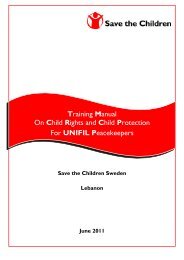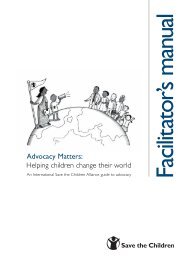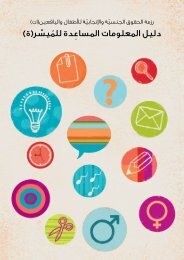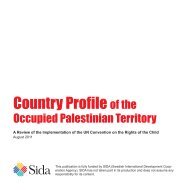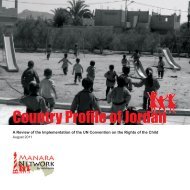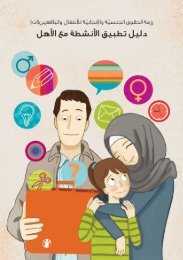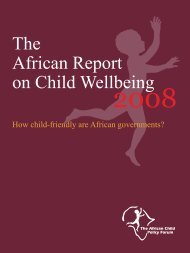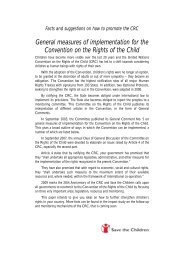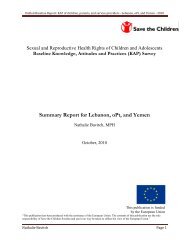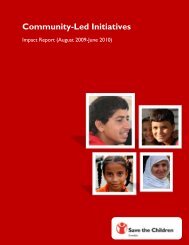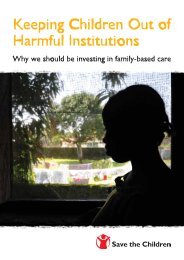Country Profile of Morocco - International Bureau of Children's Rights
Country Profile of Morocco - International Bureau of Children's Rights
Country Profile of Morocco - International Bureau of Children's Rights
Create successful ePaper yourself
Turn your PDF publications into a flip-book with our unique Google optimized e-Paper software.
A survey on school health was carried out, although the<br />
results were not available at the writing <strong>of</strong> this report. 155<br />
The Ministry <strong>of</strong> Health has a department fully dedicated<br />
to school health. 156 The National Programme for School<br />
and University Hygiene was launched in 2006 with the<br />
mobilisation <strong>of</strong> health centres and doctors to ensure<br />
systematic medical visits and a medical school booklet for<br />
every child. The initiative sought to fight visual deficiencies<br />
and transmissible ophtalmia, promote oral health,<br />
prevent transmissible diseases, supervise summer camps,<br />
control hygiene conditions and develop education in<br />
sanitation. 157 Since schools are more numerous than health<br />
centres, the MNE and UNICEF launched a pilot project<br />
using voluntary instructors to ensure the role <strong>of</strong> health<br />
auxiliaries in 61 rural schools (in Chefchaouen, Essaouira,<br />
Ouarzazate, Zagora and Al-Haouz). These auxiliaries<br />
conducted awareness classes, ensured first aid, contributed<br />
to the management <strong>of</strong> medical files and referred sick<br />
students to the nearest health centre. 158<br />
Finally, in 2008, a child psychiatry unit at Ibn Rushd Hospital<br />
<strong>of</strong> Casablanca was opened. This unit is an important<br />
advance in the field, but obviously cannot meet the current<br />
national demand. 159<br />
b.<br />
Nutrition<br />
Hunger in <strong>Morocco</strong> decreased from 4.6% in 1990 to<br />
0.9% in 2008<br />
35<br />
160 ; this success, however, masked another<br />
problem: “hidden hunger” or malnutrition. In fact, almost<br />
one-third <strong>of</strong> the population suffers from malnutrition due<br />
to a lack <strong>of</strong> micronutrient intake, i.e. the lack <strong>of</strong> vitamins<br />
and minerals. Malnutrition is responsible for half <strong>of</strong> the<br />
cases <strong>of</strong> child and adolescent mortality. 161 While chronic<br />
malnutrition has declined from 28% to 18% between 1997<br />
and 2003/2004, acute malnutrition has tripled from 3%<br />
to 9.3%, even reaching 11.1% in some rural areas. This<br />
malnutrition, which affects primarily women and chil-<br />
dren, has been at the core <strong>of</strong> several regional campaigns<br />
promoting foods rich in micronutrients and iron and<br />
vitamin-enriched flour. One in three children, one in three<br />
women and one in five men suffer from iron deficiency. 162<br />
This deficiency costs the country USD250 million per<br />
year—5% <strong>of</strong> the GDP. 163<br />
In 2004, the Ministry <strong>of</strong> Health developed a national<br />
strategy for the promotion <strong>of</strong> breastfeeding and good<br />
practices in infant feeding, in accordance with the global<br />
strategy <strong>of</strong> infant and child nutrition launched that<br />
same year by the World Health Organisation (WHO) and<br />
UNICEF. The strategy emphasized four components:<br />
supplementation, nutrition education, food fortification<br />
and capacity-building.<br />
c.<br />
Reproductive Health<br />
The use <strong>of</strong> contraceptives by married women (15 to 49<br />
years) has increased significantly from 42% in 1990 to<br />
63% in 2004. However, a gap remains between regions<br />
with 65.5% <strong>of</strong> women in urban areas using contraceptives<br />
compared with 59.7% <strong>of</strong> women in rural areas. Family<br />
planning in <strong>Morocco</strong> is oriented towards the use <strong>of</strong><br />
modern contraceptive methods including the combined<br />
oral contraceptive pill, the most common method used by<br />
women. The birth control pill, although originally issued<br />
by prescription, is now available without prescription in<br />
most pharmacies, along with the “morning after pill” and<br />
condoms.<br />
In its Concluding Observations <strong>of</strong> 2003, the Committee<br />
was concerned that insufficient attention had been given<br />
to adolescent health issues, including developmental,<br />
mental and reproductive health concerns. The Committee<br />
was also concerned at the high percentage <strong>of</strong> early<br />
pregnancies, which can have a negative impact on girls’<br />
health and education. The Committee recommended that




